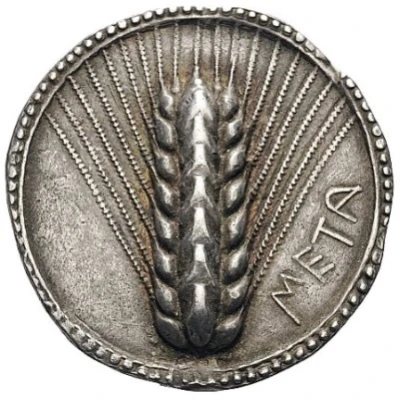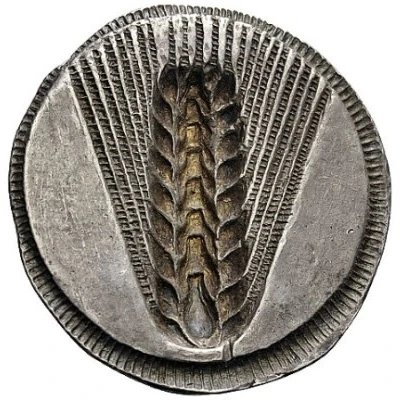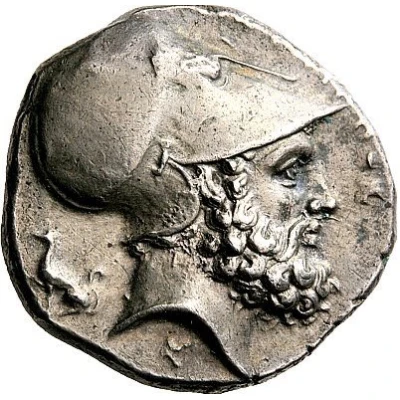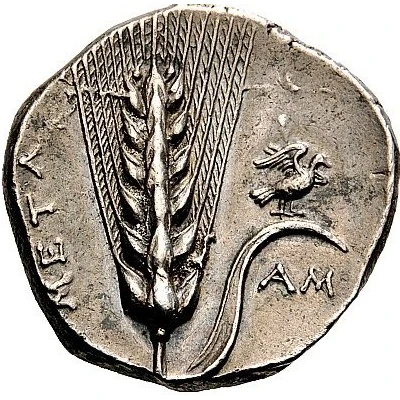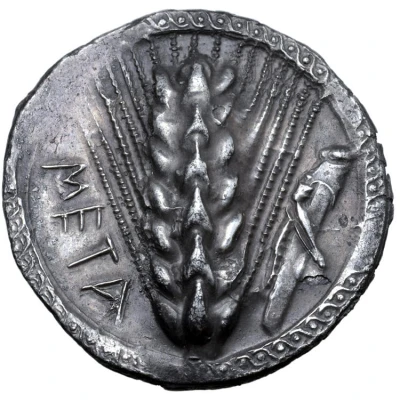
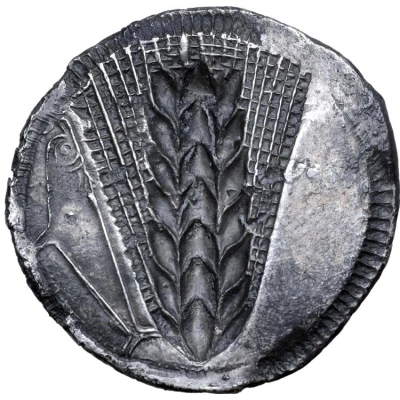

Stater 510 BC
510 BC year| Silver | 7.95 g | 28 mm |
| Issuer | Metapontion (Lucania) |
|---|---|
| Type | Standard circulation coin |
| Year | 510 BC |
| Value | Silver Stater (3) |
| Currency | Drachm (540-200BC) |
| Composition | Silver |
| Weight | 7.95 g |
| Diameter | 28 mm |
| Shape | Round (irregular) |
| Technique | Hammered, Incuse |
| Orientation | Variable alignment ↺ |
| Demonetized | Yes |
| Updated | 2024-10-10 |
| Numista | N#195451 |
|---|---|
| Rarity index | 100% |
Reverse
Incuse barley ear, dolphin upwards to left in linear relief.
Comment
Gorini 10-11 and p. 136-137; Locker-Lampson 18; Traité I pl. LXVI, 9.
About the meaning of the grasshopper and dolphin, from Roma Numismatics Auction XVII Catalog:
A brief series comprising only four known obverse dies for the staters and one for a third stater marks the first usage of adjunct symbols on the coinage of Metapontion. The meaning of the grasshopper and the dolphin has been a subject of debate for many years. Noe advocated the symbols as representing the badges of the moneyers' houses, an argument not dissimilar to that which led the early archaic Athenian coins to be called 'wappenmünzen'. Lenormant's view that the insect has a propitiatory significance is rejected with the derisory rhetorical question 'there may have been a plague of locusts but could there have been a plague of dolphins?', while avoiding trying to explain its significance.
Babelon (Traité, 1395-1396) proposed a punning reference to the hero Alybas, father of Metabos, and legendary founder of the city, however the Greek word he proposes to mean locust is incorrect, and the argument founders, still failing to explain the dolphin. It is most logical to follow Lenormant and view the appearance of the grasshopper-locust on the coins as being a propitiatory emblem or commemorating the deliverance of the city from a plague of locusts through the intervention of Apollo. Indeed, the god is closely associated with afflictions (and the relief of), and had as one of his epithets 'Parnopios', from πάρνοψ, "locust" - the expeller of locusts. Given that the dolphin was both a form he had taken and one of his sacred animals, as well as being a punning allusion to him as Apollo Delphinios, it seems eminently reasonable to determine the link between the two symbols as being in reference to a plague of locusts whose abatement was attributed to the intervention of Apollo. That the grasshopper-locust symbol recurs several times more throughout the extensive coinage of Metapontion and at appreciable intervals is hardly suggestive of descendants of a particular family holding office, as Noe suggested, but rather more likely indicative of recurrent swarms threatening the principle source of the city's wealth and food.
Interesting fact
The Metapontion Stater coin features a unique design on its reverse side, depicting a large, stylized ear of barley, which was a symbol of fertility and prosperity in ancient Greek culture. This design was specifically chosen to represent the city of Metapontion, which was known for its rich agricultural land and bountiful harvests. The coin's design serves as a testament to the city's rich history and cultural heritage.
Price
| Date | Mintage | VG | F | VF | XF | AU | UNC |
|---|---|---|---|---|---|---|---|
| ND (-510) | - | - | - | - | - | - |
Values in the table are based on evaluations by sales realized on Internet platforms. They serve as an indication only for Stater (510 BC) coin.
